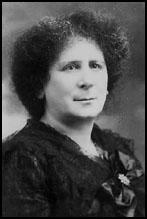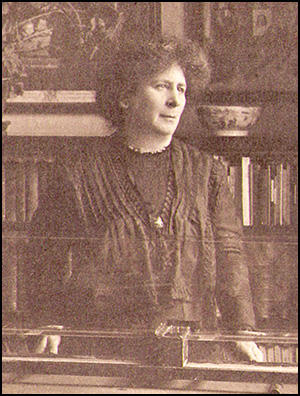Hertha Ayrton (original) (raw)

Phoebe (Hertha) Marks, the daughter of a watchmaker, was born in Portsea, Hampshire, on 28th April 1854. She was educated at home and one of her tutors was Eliza Orme, who taught her mathematics. From the age of sixteen she worked as a governess. She adopted the name "Hertha" after the heroine of an Algernon Charles Swinburne poem that criticized organized religion.
In 1875 Orme wrote to Helen Taylor, to tell her about the desire of Hertha to study mathematics at Girton College. With the financial help of Taylor and Barbara Bodichon she was able to attend Girton between 1877 and 1881.
After leaving university she taught at Notting Hill and Ealing High School. In 1872 Hertha Marks joined the Hampstead branch of the Central Society for Women's Suffrage. In 1885 the line divider she had invented and patented was shown at the Exhibition of Women's Industries organised in Bristol by Helen Blackburn. In 1885 she married Professor William Ayrton, a widower whose first wife, Matilda Chaplin Ayrton (1846-1883), had been a doctor and a member of the London National Society for Women's Suffrage. He was the father of Edith Ayrton, who was later to play a significant role in the struggle for women's suffrage. Hertha's daughter, Barbara Ayrton, was born in 1886.
Hertha Ayrton continued with her scientific research, working from a laboratory in her house. She also remained active in the London National Society for Women's Suffrage and the National Union of Suffrage Societies. Frustrated by the lack of progress in achieving the vote she accepted that a more militant approach was needed and in 1907 she joined the Women Social & Political Union. Left a considerable amount of money by Barbara Bodichon, she also gave generously to the WSPU. The 1909-10 WSPU accounts show that she gave £1,060 in that year. In 1910 she joined Emmeline Pankhurst and Elizabeth Garrett Anderson in a deputation to the House of Commons.
In a letter she wrote to Maud Arncliffe Sennett, Hertha admitted: "I made up my mind some time ago that as I am unable to be militant myself, from reasons of health, and as I believe most fully in the necessity for militancy, I was bound to give every penny I can afford to the militant union that is bearing the brunt of the battle, namely the WSPU."
In March 1912 the British government made it clear that they intended to seize the assets of the WSPU. According to Evelyn Sharp Hertha Ayrton helped to "launder" through her bank account the funds of the WSPU. The WSPU bank manager was subpoenaed to appear at the conspiracy trial and revealed that £7,000 had been paid to "someone named Ayrton".

Hertha Ayrton
In November 1912 Hertha Ayrton helped form the Jewish League for Woman Suffrage. The main objective was "to demand the Parliamentary Franchise for women, on the same terms as it is, or may be, granted to men." One member wrote that "it was felt by a great number that a Jewish League should be formed to unite Jewish Suffragists of all shades of opinions, and that many would join a Jewish League where, otherwise, they would hesitate to join a purely political society." Other members included Edith Ayrton, Henrietta Franklin, Hugh Franklin, Lily Montagu, Inez Bensusan and Israel Zangwill.
Militants in the Jewish League for Woman Suffrage disrupted Sabbath worship services in several synagogues in London from early 1913 until the outbreak of First World War, demanding religious as well as political suffrage for women. These women were forcibly removed from synagogues for disrupting services and castigated in the Anglo-Jewish press as “blackguards in bonnets.”
The summer of 1913 saw a further escalation of WSPU violence. In July attempts were made by suffragettes to burn down the houses of two members of the government who opposed women having the vote. These attempts failed but soon afterwards, a house being built for David Lloyd George, the Chancellor of the Exchequer, was badly damaged by suffragettes. This was followed by cricket pavilions, racecourse stands and golf clubhouses being set on fire.
Some leaders of the WSPU such as Emmeline Pethick-Lawrence, disagreed with this arson campaign. When Pethick-Lawrence objected, she was expelled from the organisation. Others like Louisa Garrett Anderson and Elizabeth Robins showed their disapproval by ceasing to be active in the WSPU. Sylvia Pankhurst also made her final break with the WSPU and concentrated her efforts on helping the Labour Party build up its support in London. During this period Hertha Ayrton stopped funding the WSPU.

The Vote (1st September, 1923)
In February 1914 Hertha became a leading member of the United Suffragists. The group were disillusioned by the lack of success of the National Union of Women's Suffrage Societies and disapproved of the arson campaign of the Women Social & Political Union, decided to form a new organisation. Membership was open to both men and women, militants and non-militants. Members included Emmeline Pethick-Lawrence, Frederick Pethick-Lawrence, Evelyn Sharp, Henry Nevinson, Margaret Nevinson, Edith Ayrton, Israel Zangwill, Lena Ashwell, Louisa Garrett Anderson, Eveline Haverfield, Maud Arncliffe Sennett, John Scurr, Julia Scurr and Laurence Housman.
During the First World War Hertha Ayrton devised a simple anti-gas fan that could be used in the trenches on the Western Front. Unfortunately, she was unable to persuade the British Army to employ the device.
Hertha Ayrton died on 23rd August 1923.